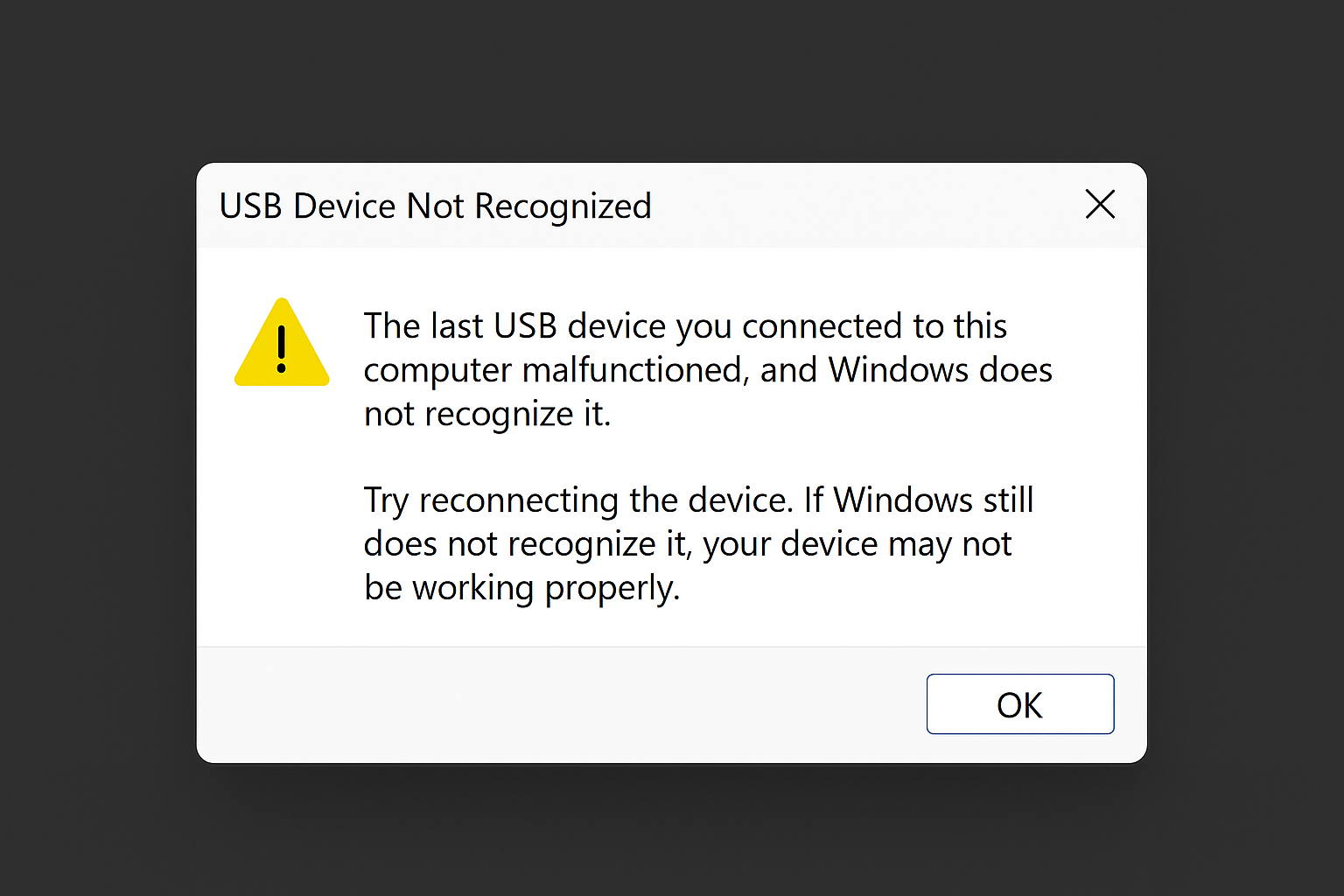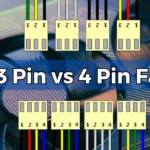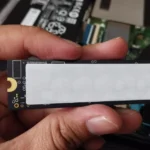Fix – usb device not recognized

USB Device Not Recognized Error on PC — Complete Fix Guide (2025)
Last updated: October 2025 | Category: PC Hardware, Windows Fixes
If your computer suddenly pops up the message “USB device not recognized” or your flash drive refuses to appear, you’re not alone. This issue affects millions of Windows users every year. Whether it’s a mouse, keyboard, external hard drive, or flash drive, this guide gives you every method—tested, verified, and explained—to fix it once and for all.
We spent hours researching Microsoft’s official documentation, Reddit threads, and tech support forums to bring you the most effective, real-world fixes.
Common Symptoms
- Windows shows “Unknown USB Device (Device Descriptor Request Failed)”
- USB device doesn’t appear in File Explorer
- No sound or light indicator when plugging in
- Other devices or ports might still work
Quick 60-Second Fix (Try These First)
- Unplug the device and plug it into a different USB port — preferably one on the back of your PC.
- Use another cable or test the device on a different computer.
- Restart your PC — completely shut it down, wait 10 seconds, and boot up again.
- Open Device Manager → Universal Serial Bus controllers → USB Root Hub → Properties → Power Management and uncheck “Allow the computer to turn off this device to save power.”

Why This Error Happens
There’s not just one cause behind the “USB Device Not Recognized” error. It can stem from:
- Faulty cables or connectors – the most common reason.
- Power supply issues – USB ports not delivering enough voltage.
- Driver corruption – Windows fails to properly load the device’s driver.
- Selective suspend or sleep – Windows puts USB hubs to sleep and fails to wake them.
- Firmware or BIOS issues – outdated firmware on your motherboard or laptop can cause enumeration errors.
Step-by-Step Fix Guide
1. Basic Hardware Checks
Try different cables and ports. If it’s an external hard drive or keyboard, plug directly into your PC—not through a hub. If it works on another PC, the issue is local to your system.
2. Power Cycle Everything
Completely power off your PC and unplug it for 30–60 seconds. Disconnect all USB devices, then boot up and plug them back in one by one. This resets your USB controller and power state.
3. Device Manager Quick Fix
In Device Manager:
- Expand Universal Serial Bus controllers.
- Right-click each USB Root Hub → Uninstall device.
- Restart your computer — Windows will reinstall clean drivers automatically.
4. Remove Hidden/Old USB Drivers
Old or ghost drivers can confuse Windows. To remove them:
set devmgr_show_nonpresent_devices=1 start devmgmt.mscIn Device Manager → View → “Show hidden devices”. Uninstall any grayed-out entries under “Universal Serial Bus controllers”.
5. Disable USB Selective Suspend
In Control Panel → Power Options → Change Plan Settings → Advanced → USB Settings → USB Selective Suspend → Disable. This ensures Windows doesn’t cut power to USB ports when idle.
6. Update Drivers and BIOS
Go to your motherboard or laptop manufacturer’s support page and install the latest chipset and USB drivers. Also, update BIOS/UEFI firmware—it often includes USB compatibility fixes.
7. Run System File Checks
Corrupted system files can stop driver communication. Run these commands in an Administrator Command Prompt:
sfc /scannow DISM /Online /Cleanup-Image /RestoreHealth8. Check for Device Error Codes
If you see Code 43 or “Device Descriptor Request Failed”, that means Windows tried to talk to the device but it reported a failure. Usually, reinstalling drivers or testing on another PC confirms whether it’s hardware-related.
9. Try Disabling Fast Startup
Fast Startup can keep USB states in memory. Disable it from Control Panel → Power Options → Choose what power buttons do → Uncheck “Turn on fast startup.” Reboot and test again.
10. Powered Hubs for External Drives
If your external HDD or SSD needs more power than the port provides, use a powered USB hub. This can instantly fix random disconnects or non-detection issues.
11. Test in Safe Mode
Boot your PC in Safe Mode with Networking. If your USB device works there, a third-party driver or software is conflicting in normal mode.
12. Advanced Tools
For power users:
- Use USBDeview (NirSoft) to view all devices that were ever connected and clean old ones.
- Use USBView (Microsoft) to inspect low-level descriptors—helpful to diagnose if Windows even detects the device at all.
Preventing USB Errors in the Future
- Always use quality, short USB cables for high-power devices.
- Keep your chipset and BIOS updated from the manufacturer’s site.
- Use powered hubs for multiple devices.
- Avoid unplugging storage devices without ejecting safely.
- Clean dust and check ports for looseness every few months.
Advanced Fixes (For Persistent USB Recognition Problems)
If your device still isn’t recognized after following all the above steps, these advanced methods go deeper — tackling power delivery issues, registry-level fixes, firmware conflicts, and hardware diagnostics that most guides skip.
1. Fully Reset USB Controllers and Chipset Drivers
Sometimes Windows reinstalls partial drivers, leaving bad registry entries. To completely reset them:
- Open Device Manager → Expand Universal Serial Bus controllers.
- Right-click and Uninstall device for every “USB Host Controller” and “USB Root Hub.”
- Restart your PC.
- After reboot, install the latest chipset and USB drivers from your motherboard or laptop manufacturer’s support site (not Windows Update).
2. Clear Windows “Ghost Devices” via Command Line
Over time, Windows stores device data for every USB you’ve ever connected — sometimes thousands of entries. Too many stale records can cause driver conflicts.
set devmgr_show_nonpresent_devices=1
start devmgmt.mscNow in Device Manager → View → Show hidden devices. Remove all gray, disconnected USB devices under:
- Universal Serial Bus controllers
- Disk Drives
- Human Interface Devices (if you had old peripherals)
3. Disable Fast Boot in BIOS/UEFI
Modern motherboards skip USB initialization to speed up startup. Disabling Fast Boot forces a full power cycle of USB controllers every boot.
- Enter BIOS (press F2, F10, or Del on startup).
- Find “Fast Boot” or “Ultra Fast Boot” and set it to Disabled.
- Save & exit, then test again.
4. Registry Refresh (Safe USB Key Cleanup)
Warning: Only proceed if you’re confident editing the Windows registry. Back it up first (File → Export in regedit).
Navigate to:
HKEY_LOCAL_MACHINE\SYSTEM\CurrentControlSet\Enum\USBLocate entries named VID_XXXX&PID_YYYY that match your malfunctioning device (you can check Hardware IDs in Device Manager). Right-click that device key and delete it. Then unplug and reinsert the USB device — Windows will rebuild its profile fresh.
5. Rebuild Windows’ Power Configuration
Power plans can sometimes store corrupted USB power settings. To reset them completely, run this in an admin Command Prompt:
powercfg -restoredefaultschemesThen reconfigure your preferred settings in Control Panel → Power Options.
6. Disable USB Selective Suspend via Command Line
You can also disable selective suspend directly using this PowerShell command:
powercfg /change standby-timeout-ac 0
powercfg /setacvalueindex SCHEME_CURRENT SUB_USB USBSELECTSUSPEND 0
powercfg /setactive SCHEME_CURRENT7. Inspect USB Descriptors (Confirm Hardware Response)
Use Microsoft’s USBView or NirSoft’s USBDeview to confirm whether Windows detects any descriptor at all. If there’s no Vendor ID (VID) or Product ID (PID), the issue is physical — cable, port, or device controller failure.
8. Check for Short Circuits or Damaged Ports
- Inspect your USB ports using a flashlight. Look for bent pins or metal contacts touching the sides.
- If the same port fails across multiple devices, it might have a short circuit. Avoid using that port — it could damage other peripherals.
9. Run Hardware & BIOS-Level Diagnostics
Some OEMs like Dell, HP, and Lenovo include hardware test tools accessible via F12/F9/F10 during startup. Run those diagnostics to verify the USB controller and chipset are functioning correctly at the hardware level.
10. Test with Linux Live USB
This is the ultimate OS-level isolation test. Create a Linux live USB (Ubuntu, Pop!_OS, etc.) using Rufus. Boot from it and test your device there:
- If it works, your Windows installation or drivers are at fault.
- If it doesn’t, the problem is with your hardware or the device itself.
11. For External Hard Drives — Check Partition and Disk Health
Sometimes the drive is recognized but doesn’t mount due to partition errors.
- Open Disk Management (Win + X → Disk Management).
- See if the drive appears there (even without a letter).
- If it shows as “Unallocated,” right-click and choose “New Simple Volume.”
Run a quick health check using Command Prompt:
chkdsk X: /f(Replace “X” with the actual drive letter.)
12. Motherboard & Port Power Reset (Deep Power Drain)
If none of the above worked, try a deep CMOS and USB power reset:
- Shut down the PC and unplug the power cable.
- Hold the power button for 15–20 seconds to discharge residual current.
- Wait one minute, reconnect, and start again.
This clears “stuck” USB controller states at the hardware level.
13. Update or Roll Back Windows Version
Windows updates occasionally break USB stacks. Check Device Manager → Events for driver installation timestamps. If the issue started after an update, roll back to a previous version or reinstall the USB driver manually.
14. Try a Powered USB Hub or PCIe USB Expansion Card
If all ports seem unreliable, a powered USB hub or dedicated PCIe expansion card (with its own controller) can bypass faulty motherboard ports entirely.
When All Else Fails — Data Recovery & Replacement
If a USB storage device is physically dead or partially responsive, you can attempt data recovery with tools like Recuva, R-Studio, or EaseUS Data Recovery. For critical data, professional recovery labs can extract data directly from the NAND chip using specialized hardware.
If even Linux or other systems can’t detect it, replacing the USB device is the only option.
Final Advanced Checklist
- Reset chipset and USB drivers completely
- Clear all ghost devices and registry entries
- Disable Fast Boot (Windows + BIOS)
- Test with Linux live USB
- Use powered hubs or PCIe expansion cards for consistent power
- If hardware still fails, replace the device or port
Key Takeaway
90% of persistent USB recognition problems are fixable through driver cleanup, chipset updates, and power state resets. The remaining 10% are genuine hardware failures — often physical port or controller damage.
By following all sections in this guide — from basic checks to advanced registry cleanup — your USB device should either start working again or you’ll know exactly what part of the chain has failed.
FAQ
1. My keyboard and mouse stopped working too!
Try connecting them to a different port or use a PS/2 adapter if available. Also, enable “Legacy USB Support” in BIOS if disabled.
2. Is this only a Windows 11 problem?
No. It occurs across Windows 7, 10, and 11 — it’s usually hardware or driver-related, not version-specific.
3. Can Windows Update cause this?
Occasionally. A recent update might install a driver that conflicts. In that case, roll back the last driver update or reinstall the chipset driver manually.
4. The device works on another PC — what now?
That confirms your USB drivers or power settings are the issue. Reset your USB controllers (see Step 3), disable selective suspend, and check BIOS updates.
5. Is my USB drive dead?
If it doesn’t work on any PC or with any cable, it’s likely dead. You can try data recovery tools or contact a data recovery specialist.
Final Thoughts
The “USB Device Not Recognized” error can seem scary, but in most cases, it’s fixable with a few simple steps. Hardware issues account for more than half of these cases, while outdated drivers and power-saving settings cause the rest. With proper maintenance—quality cables, up-to-date drivers, and smart power settings—you can keep your PC’s USB system healthy for years.
Follow the checklist below to summarize everything:
- Try new cable & port
- Power cycle system
- Uninstall USB controllers
- Disable selective suspend
- Update drivers & BIOS
- Use powered hub for heavy devices



![Logic Board vs Motherboard [Explained] 11 Logic Board vs Motherboard](https://pcexplorers.com/wp-content/uploads/2024/10/Logic-Board-vs-Motherboard-150x150.webp)

